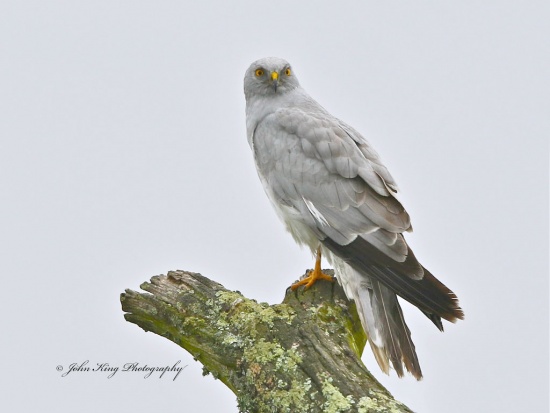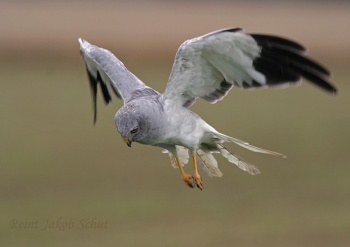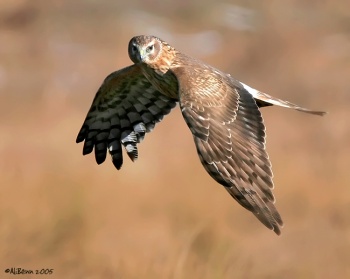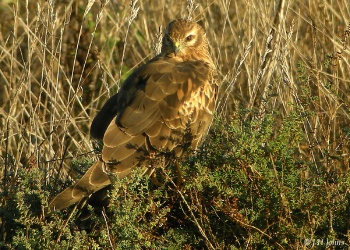- Circus cyaneus
Identification
A medium-sized raptor, 42–50 cm (16½-19½ in) long and 97-118 cm wing span; males smaller (300-400 g), females larger (410-700 g)
Male
- Grey head and upper parts
- Six black outer primaries
- White rump
- Back, wing (except for outer primaries) and tail plain pale silvery grey, with narrow darker trailing edge on wings
Female
- Quite a bit larger than the male
- Brown upperparts
- Brownish-white underparts
- Very noticeable white rump
Juvenile
- Similar to adult female
Flight
- Shows five obvious 'fingered' (emarginated) primaries unless in moult.
Similar species
The North American Northern Harrier, a rare vagrant in western Europe, has upperparts mottled dark grey and flanks and breast rufous-spotted in males, darker upperparts in females, and more orange underparts in juveniles than Hen Harrier.
Also see Montagu's Harrier and Pallid Harrier which both show four 'fingered' primaries in flight; Montagu's also has dark secondary bar, and Pallid only 3-4 black primaries in male. Also see other harriers depending on where the observation is done; in Europe, Western Marsh Harrier is heavier with broader wings.
Distribution
Widespread in Europe and Asia.
Breeds widely between around 35°N and 65°N latitudes across the entire width of the landmass. In Europe the main breeding range is from central Sweden, Finland and the Baltic States, south to the Black Sea and east to the Urals. However, also breeds patchily in Ireland and northern Britain (nearly extinct due to illegal persecution), in north and central France and northern Spain, with smaller populations in the Netherlands, Denmark and central Norway, Germany, Poland and the Czech Republic. Recently bred for the first time for many years in Italy.
The Asian range extends from the Urals to the Pacific coast, breeding in the Russian far east, on Kamchatka and Sakhalin, and northern and eastern China.
It is a summer visitor in Scandinavia, Russia and northern China, but resident or partly so in western and central Europe. Widespread in winter from British Isles, France and Spain east to the Black and Caspian Seas. Small numbers winter in Morocco and Egypt and can be seen on the major migration routes but relatively few cross the Mediterranean. Recorded in some numbers at Falsterbo, peaking in early-mid October.
Asian populations winter south to Japan, southern China south of the Yangtze, and northern India; a rare straggler to Taiwan.
A vagrant north to Iceland and the Faroes and to several Middle Eastern countries.
Taxonomy
This is a Monotypic species[1][2].
Formerly included Northern Harrier (and still so by Howard & Moore[7]), and sometimes also Cinereous Harrier[8], as subspecies; these have been split as separate species in view of the distinct morphological and ecological differences between them[2][3][4][5].
Conservation
Hen Harrier populations are secure in some areas, but in others, notably Great Britain, have suffered massive declines due to determined criminal persecution by game-shooting estates.
Habitat
Breeds in marshes, grasslands and heathlands, sometimes in mountains, often in cultivated areas.
Behaviour
Action
Like all harriers, hunts using a low, slow flight over the ground, with their wings held in a shallow "V", then plunge onto their prey.
Diet
Their main diet consists of small mammals, birds, reptiles, insects, and carrion.
Breeding
They build a nest of sticks and grass on the ground in thick heather, grass or shrubs. The clutch contains three to six eggs which are incubated by the female for 29 - 31 days, fledging about a month later.
They take 2 - 3 years to mature, but may attempt breeding in their first year.
Vocalisation
Call: kek, kek, kek
References
- Clements, J. F., T. S. Schulenberg, M. J. Iliff, S. M. Billerman, T. A. Fredericks, B. L. Sullivan, and C. L. Wood. 2019. The eBird/Clements Checklist of Birds of the World: v2019. Downloaded from http://www.birds.cornell.edu/clementschecklist/download/
- Gill, F. and Donsker, D. (Eds). 2017. IOC World Bird Names (version 7.3). Available at http://www.worldbirdnames.org/.
- Simmons, R. E. (2000). Harriers of the World. OUP, Oxford, UK.
- Ferguson-Lees, J., & Christie, D. A. (2001). Raptors of the World. Houghton Mifflin Co., Boston, New York.
- Dobson, A. D. M., & Clarke, M. L. (2011). Inconsistency in the taxonomy of Hen and Northern Harriers: causes and consequences. British Birds 104:192-201.
- Collins Field Guide 5th Edition
- Dickinson, E. C., & Remsen, J. V., eds. (2013). The Howard and Moore complete checklist of the birds of the world. 4th edition vol. 1. Aves Press, Eastbourne, UK.
- Cramp, S. et al., eds. (1980). Birds of the Western Palearctic 2: 116-126.
- The Peregrine Fund
- Collins Pocket Guide to British Birds 1966
- Birdforum thread discussing the taxonomy of harriers
Recommended Citation
- BirdForum Opus contributors. (2025) Hen Harrier. In: BirdForum, the forum for wild birds and birding. Retrieved 26 April 2025 from https://www.birdforum.net/opus/Hen_Harrier
External Links
GSearch checked for 2020 platform.1







